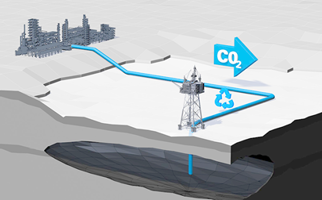
-
230 terabytes of data now available to download
-
Exploration for oil and gas, renewables and carbon storage helped by high-quality, easily-accessible information
-
Data also used to identify suitable sites for renewables
More than 60 years of seismic data from the North Sea, originally intended to help oil exploration, is now being used in a variety of innovative ways – including locating possible sites for offshore wind farms.
One year on from the relaunch of the National Data Repository (NDR) as a cloud- based system, the highly-valued archive has promoted wider access, increased high-quality reporting and reuse of data.
This means the same data which collects information such as the thickness of bedrock, the presence of depressions, faults, and gas pockets, originally for the use of the oil and gas industry could also be used in the renewable sector to help find suitable locations for windfarms or carbon storage.
Originally available in 2019, the NDR was relaunched with help from our partners Osokey and Moveout on 25 August 2021 with 15 terabytes of data online and regular users within the oil and gas industry in more than 100 companies.
Improved functionality includes the option for users of being able to preview seismic data to assess its value to projects before deciding to download it, and moving the data into cloud storage has simultaneously eliminated limits on storage capacity and made the data itself more accessible to users.
The data, which encompasses information from the early days of North Sea exploration to the present day, has been used for a variety of purposes including oil and gas exploration, locating potential sites for carbon storage, and assessing locations for windfarms, as can be seen in this case study of RockWave.
The platform has become a vital tool in the energy transition as the data is put to use by an ever-wider spread of users within – but increasingly outside of the oil and gas industry - which was its original audience, and remains a core user group.
Data requests now come in from companies which only a few years ago would not have had any use for it and also from long-time users who are now moving into new areas of the energy transition and are looking again at existing information
Now boasting 230 terabytes of data, more than 4,000 users in over 250 organisations have downloaded nearly 100TB data in the past 12 months.
The site is being constantly updated with new information with over 7,000 well data files and documents released this year and over 100 terabytes of seismic data being uploaded recently.
Nic Granger, NSTA Director of Corporate, said:
“The NDR is the place to go for information about the North Sea – whether your interest is oil and gas, carbon storage or wind, the data is there and freely available.
“The incredible thing about this data is that originally, it was reported to NSTA so industry could know where best to drill for oil and gas. Now that same data can help provide the best locations for renewable energy production like wind farms.
“Users have given the relaunched site a thumbs-up, but we are always working to add more data and improve accessibility to make it even more responsive to industry needs.”
Prof John Underhill, Interdisciplinary Director for Energy Transition, The University of Aberdeen, and Executive Director of the UK’s Centre for Doctoral Training (CDT) GeoNetZero, said:
“The National Data Repository (NDR) is a rich and extremely valuable source of scientific data that forms the bedrock of numerous world-leading academic research studies. Access to high fidelity seismic, well log, pressure and core data acquired in the pursuit of oil and gas has enabled a new understanding of the sedimentary basins on the UK’s continental shelf.
“The subsurface characterization that has been enabled by the NDR is crucial in determining the best use of offshore areas for carbon storage, hydrogen production, wind energy and geothermal as the UK seeks to decarbonize to meet its net zero emissions targets. As such, the NDR is playing a pivotal role in extending the life of the North Sea in the energy transition.”
Steve Murphy, Storegga Chief Commercial Officer, said:
“The NDR has been invaluable to us for several years as we navigate the complex and changing landscape around carbon capture and storage. High-quality data has a vital role to play in the global energy transition. The NDR allows us to harness the 78GT potential of the North Sea as a site for a nascent CO2 storage industry in the most cost-effective way.
“Now more than ever, open access to existing data will allow critical projects to be developed and become operational as soon as possible. We welcome the NDR's consistent drive towards innovation at this crucial moment on the path towards Net Zero.”
The NDR – which can be accessed at https://ndr.nstauthority.co.uk/ – is available free of charge, with organisations able to download as much as three terabytes per calendar month without charge.
For further information please contact:
Tel: 07785 655620
Email: pressoffice@nstauthority.co.uk
Notes to Editors


